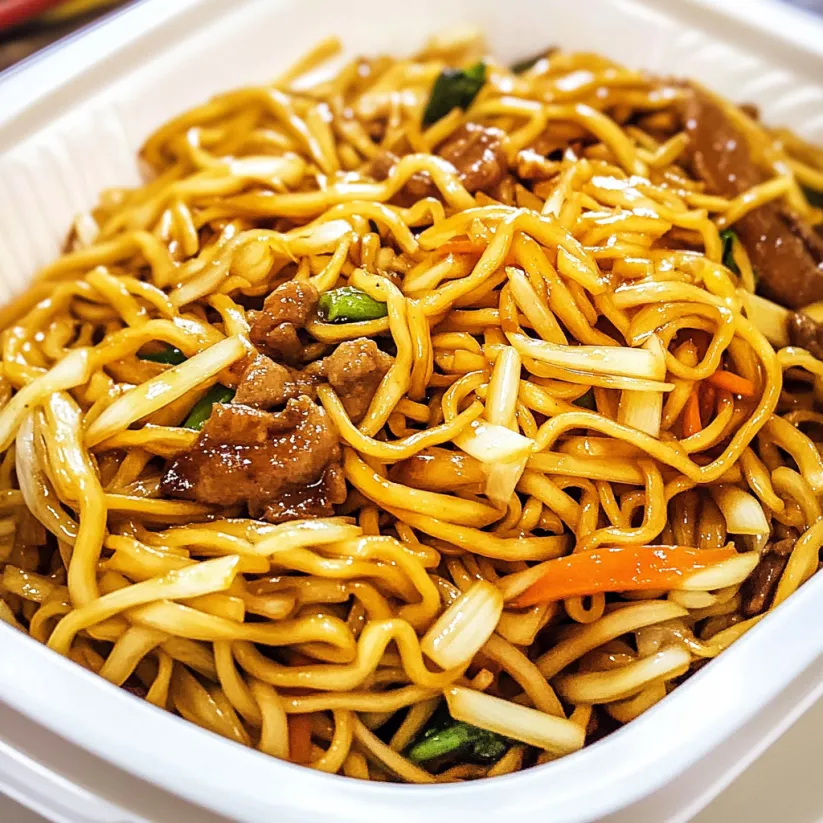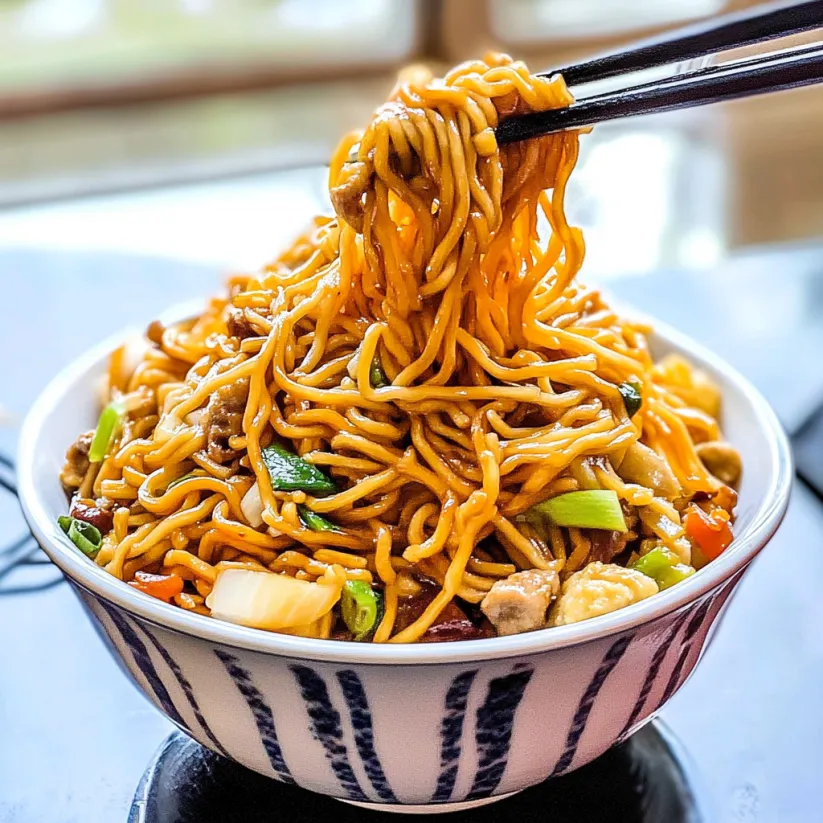 Bookmark
Bookmark
This homemade chow mein has become my weeknight lifesaver, delivering authentic takeout flavor right from my kitchen in just 15 minutes. The perfect balance of tender noodles, crisp vegetables, and savory sauce creates a dish that consistently disappears faster than I can serve it.
I discovered this recipe during a particularly busy month when takeout bills were mounting. After perfecting this version, my family now requests homemade chow mein over delivery every time.
Ingredients
- Water Makes the base for our sauce while helping thin out the strong flavors
- Soy sauce Low sodium version gives control over saltiness without sacrificing flavor
- Oyster sauce The secret ingredient providing that unmistakable umami depth that defines true chow mein
- Chinese cooking wine Adds subtle complexity and authenticity that transforms homemade Asian dishes
- Dark soy sauce Just a teaspoon provides beautiful color and rich dimension
- Sesame oil A small amount adds tremendous nutty aroma and authentic flavor
- Brown sugar Balances the savory elements with just the right touch of sweetness
- Cornstarch Creates the perfect sauce consistency that clings to every noodle
- Peanut oil Best for high heat cooking with a clean flavor that doesn't overpower
- Garlic Fresh minced cloves create an aromatic foundation
- Carrots Julienned for quick cooking and visual appeal
- Cabbage Napa cabbage provides the perfect tender crunch when slightly wilted
- Chow mein noodles Look for fresh ones in the refrigerated section for best texture
- Green onions Adds bright color and fresh flavor
- Bean sprouts Provides signature crunch and freshness
Step-by-Step Instructions
- Prepare the sauce
- Mix hot water, soy sauce, oyster sauce, Chinese cooking wine, dark soy sauce, sesame oil, brown sugar, and cornstarch until completely smooth. Hot water helps dissolve the sugar and cornstarch while ensuring they fully incorporate without lumps.
- Heat the wok
- Add peanut oil to your wok or large skillet and heat until just smoking. A properly heated wok is crucial for authentic chow mein texture where vegetables retain their crispness.
- Sauté aromatics
- Add minced garlic and stir constantly for exactly 30 seconds. This brief cooking time ensures the garlic infuses the oil without burning, which would create bitterness.
- Cook the vegetables
- Add julienned carrots and stir continuously for one minute until they just begin to soften. The goal is to maintain some texture while taking away the raw edge. Add cabbage and continue cooking for two minutes until just wilted but still bright.
- Combine noodles and sauce
- Add chow mein noodles directly to the vegetable mixture. Pour your prepared sauce over everything, making sure to give the sauce a quick stir first to redistribute any settled cornstarch. Allow the sauce to bubble and coat the noodles for about 2 minutes before tossing.
- Final toss
- Continue cooking while tossing the ingredients together for 3 to 5 minutes. Watch carefully as the noodles absorb the sauce and become tender. The sauce will thicken and cling beautifully to every strand.
- Finish with fresh elements
- Add green onions and bean sprouts, tossing just until incorporated. The residual heat will slightly wilt these ingredients while maintaining their fresh crunch and bright flavor.
- Serve immediately
- Transfer to serving dishes while still hot. The textures are at their peak when freshly made, with the perfect balance of tender noodles and crisp vegetables.
 Bookmark
Bookmark
Oyster sauce is my non negotiable ingredient in this recipe. When I first attempted chow mein without it, something was noticeably missing. That rich, savory depth simply cannot be replicated, and it's what transforms this dish from good to restaurant quality.
Protein Additions
Adding protein to this vegetarian base creates endless variations. For chicken chow mein, slice boneless thighs into thin strips and sauté them first in the hot oil until just cooked through. Remove the chicken, proceed with the recipe as written, then return the chicken to the wok when adding the noodles. This technique works beautifully with thinly sliced beef, pork, or even jumbo shrimp which need only about two minutes of cooking time.
Noodle Know-How
The type of noodle you select significantly impacts the final dish. Traditional chow mein noodles are made from wheat flour and eggs, giving them their characteristic texture and slight chewiness. If unavailable, substitute with fresh yakisoba noodles or even dried spaghetti in a pinch. Fresh noodles need only a quick blanch according to package directions before adding to the wok, while dried noodles should be cooked to just before al dente, as they'll continue cooking in the sauce.
Sauce Secrets
This sauce recipe creates the perfect balance between savory, sweet, and aromatic elements. The dark soy sauce provides color while the regular soy contributes saltiness. Chinese cooking wine adds complexity that water or broth simply cannot replicate. While authentic, it can be substituted with dry sherry or even chicken broth if alcohol is a concern. For a gluten free adaptation, use tamari instead of soy sauce and verify your oyster sauce is gluten free. The cornstarch creates that signature glossy coating that distinguishes great chow mein from mediocre versions.
Make-Ahead Tips
While chow mein is best freshly made, you can prepare components ahead of time to streamline cooking. Mix the sauce up to three days in advance and store refrigerated in an airtight container. Julienne carrots, chop green onions, and shred cabbage the day before, storing each separately in the refrigerator. With these preparations complete, the final cooking process takes barely 10 minutes, making this perfect for busy weeknights when time is limited but you still want a satisfying homemade meal.
 Bookmark
Bookmark
Frequently Asked Questions
- → What protein works best with this chow mein?
This chow mein is versatile and works well with chicken, pork, beef, or shrimp. If adding protein, sauté it first in the wok with a bit of oil before adding any vegetables to ensure it's properly cooked.
- → Can I substitute the Chinese cooking wine?
While Chinese cooking wine adds authentic flavor, you can substitute with vegetable or chicken broth for an alcohol-free version. However, the cooking wine does contribute significantly to the dish's traditional taste profile.
- → What can I use if I can't find chow mein noodles?
If chow mein noodles aren't available, soba noodles or pancit noodles make excellent substitutes. Both have textures that work well with this cooking method and sauce.
- → How do I prevent the noodles from becoming mushy?
To prevent mushy noodles, follow the package instructions for cooking time and avoid overcooking them. When adding to the wok, toss frequently and only cook until they've softened but still have a slight bite to them.
- → Is this dish very salty?
The recipe doesn't call for additional salt as there's sufficient sodium from the soy sauce and oyster sauce. Using low-sodium soy sauce helps control the saltiness. You can always taste and adjust seasonings before serving.
- → What's the best way to prep vegetables for chow mein?
For best results, cut vegetables thinly and uniformly to ensure quick and even cooking. A mandoline is ideal for julienning carrots and shredding cabbage, but careful knife work also works well. Thin, consistent cuts are key to authentic texture.
